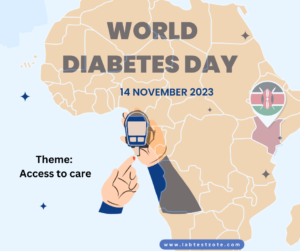What is diabetes mellitus
Diabetes mellitus is a chronic disease that affects millions of people worldwide. It’s primarily due to raised blood sugar levels, either due to a lack of hormone insulin or insensitivity to its actions.
According to the International Diabetes Federation, in 2021, there were 2.3 million cases of diabetes in Kenya, and this number is expected to rise to 3.5 million by 2045. In this article, we will provide an overview of diabetes in Kenya in 2023, including its prevalence, economic burden, healthcare services, national strategic plan, research, and living with diabetes.
As our way of commemorating this year’s World Diabetes Day on 14th Nov 2023, we want to take stock of where we are as a country.

Prevalence of Diabetes in Kenya
In Kenya, the prevalence of diabetes has been on the rise in recent years.
Diabetes is one of the non-communicable diseases(NCDs) that is a growing public health concern in Kenya. The prevalence of diabetes in Kenya is estimated to be around 4.5%, with a higher prevalence in men than in women, and it increases with age.
Risk Factors For Diabetes
While there is no single factor or cause has been identified, there are some conditions that have been shown to increase the risk of getting diabetes.
The risk factors for diabetes in Kenya include:
🩺Obesity, lack of fitness
🩺Physical inactivity
🩺unhealthy diet
🩺Family history of diabetes or genetic factors.
Recent research is also implicating chronic inflammatory states, including infections as having a bearing on diabetes.
How is Diabetes Diagnosed?
In Kenya, we use the WHO Criteria for diagnosis id diabetes mellitus. If the fasting blood sugar is more than 7.0 mmol/l on 2 or more occasions. Other authorities advocate for the use of HbA1C levels of less than 6.5% as diagnostic.
Read More: Laboratory Diagnosis of Diabetes Mellitus
While the diagnostic tests are relatively straightforward, many patients are diagnosed late due to a lack of awareness of symptoms as well as a lack of access to testing facilities.
Economic Burden of Diabetes in Kenya
Diabetes has a significant economic burden in Kenya. As a chronic condition, it is costly to manage at individual, household, community and national levels.
A cost of illness study conducted in 2022 estimated that the total annual cost of diabetes in Kenya was KES 24.6 billion (USD 230 million).
The study found that direct medical costs accounted for 60% of the total cost, while indirect costs accounted for 40%. The study also found that the economic burden of diabetes is higher in urban areas than in rural areas.
Diabetes Health Care Services in Kenya
Diabetes healthcare services in Kenya are available in both public and private health facilities. However, the distribution, availability, accessibility, quality, and readiness of diabetes healthcare services vary widely across the country. This variation is noted across geographical areas (rural vs Urban vs. peri-urban), and socioeconomic status.
In 2023, Novo Nordisk’s base of the pyramid project aims to strengthen five pillars of diabetes care in Kenya, including increased awareness of diabetes, early detection and diagnosis, access to affordable treatment, patient education and empowerment, and monitoring and evaluation.
Featured Tests: Laboratory Tests For Diabetes
-
Islet Cell Antibody TestOriginal price was: KSh7,850.00.KSh7,450.00Current price is: KSh7,450.00.
-
Oncall Plus Glucometer Strips [50s]Original price was: KSh950.00.KSh900.00Current price is: KSh900.00.
-
Oncall Plus Glucometer – Complete Starter KitOriginal price was: KSh3,750.00.KSh3,200.00Current price is: KSh3,200.00.
National Strategic Plan for Prevention and Control of NCDs 2020/21-2025/26
The National Strategic Plan for Prevention and Control of Non-Communicable Diseases (NCDs) 2020/21-2025/26 is a comprehensive plan that aims to prevent and control NCDs in Kenya, including diabetes.
The plan focuses on four strategic areas: prevention and health promotion, early detection and diagnosis, treatment and care, and surveillance, monitoring, and evaluation. The plan aims to reduce the prevalence of diabetes in Kenya by 10% by 2025.
Research on Diabetes in Kenya
Research on diabetes in Kenya has increased in recent years. The research focuses on various aspects of diabetes, including epidemiology, risk factors, diagnostics, prevention, treatment, and complications. The research has identified important groups at risk of pre-diabetes and diabetes in Kenya, including people with HIV, pregnant women, and people with mental illness.
Living with Diabetes in Kenya
Living with diabetes in Kenya can be challenging, especially for people from low-income households. The cost of diabetes management, including medication, blood glucose monitoring, and healthy food, can be a significant financial burden.
However, there are support groups and organizations that provide education, advocacy, and support for people living with diabetes in Kenya. Personal stories of people living with diabetes in Kenya can inspire and encourage others to manage their diabetes effectively.
Moving Forward: Overcoming Diabetes in Kenya
Diabetes mellitus is a growing health concern in Kenya. The prevalence of diabetes is increasing, and it has a significant economic burden. However, there are diabetes health care services, a national strategic plan, research, and support available for people living with diabetes in Kenya.
By increasing awareness, early detection, and effective management of diabetes, we can prevent and control diabetes in Kenya.
Focus on diabetes research is important. Recent research is reshaping diabetes as primarily a diet-related disease and instances of reversal have been reported. This area requires more research as the potential is immense.
Diabetes is preventable or at least can be delayed. Its serious complications can be prevented by access to quality care.
Let’s spread the message!
